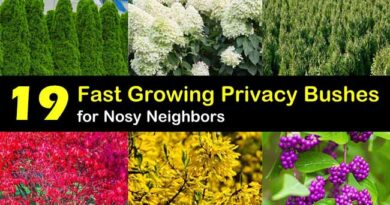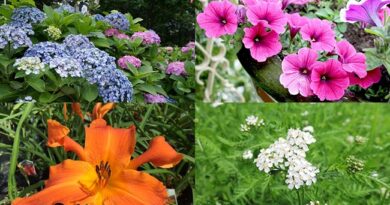38 Yellow Flower Weeds You’ll Spot in Lawns and Gardens
Have you ever taken a walk through your yard and spotted cheerful little yellow flowers blooming here and there—only to realize you never planted them? Those surprise guests are likely yellow flowering weeds! While “weed” might sound like a bad word, these plants are actually pretty tough survivors.
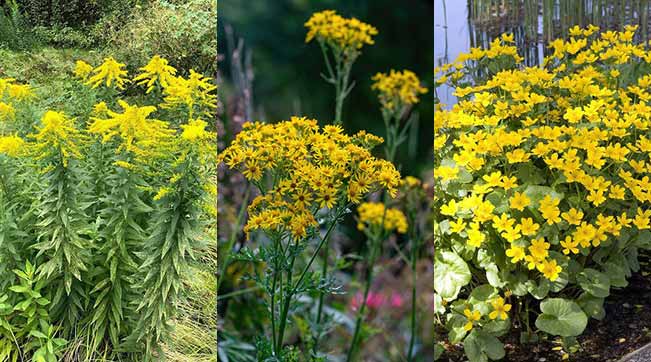
They don’t need much care, and some even help the soil or feed the bees. Plus, many of them are actually quite pretty! In this post, we’ll explore 38 different types of weeds with yellow flowers that could be hiding in plain sight. From roadside rebels to backyard wanderers, these hardy plants are more than just garden invaders—they’re nature’s little wildflowers with a twist.
1. Common St. John’s Wort
Botanical Name: Hypericum perforatum

In the heat of summer, especially between July and August, you might spot a bushy plant standing about 2 to 3 feet tall, dotted with golden-yellow flowers. That’s Common St. John’s Wort. Each flower has five bright petals and a burst of stamens in the middle, giving it a star-like appearance.
Its leaves grow in pairs, directly across from each other on the stem, and if you hold one up to the light, you’ll see tiny translucent dots—these are oil glands. This plant isn’t just a weed—it’s also famous in herbal medicine for its use in mood and anxiety support. But in your yard, it spreads fast, especially in dry, sunny areas.
________________________________________
2. Lesser Celandine
Botanical Name: Ficaria verna

This glossy yellow flower might look innocent, but Lesser Celandine is a real troublemaker in gardens and lawns. Often popping up in spring, it has heart-shaped leaves and buttercup-like flowers. The real issue?
It reproduces through both seeds and underground tubers, and it can self-pollinate too. That means once it takes hold, it’s very hard to control. It spreads rapidly and creates dense carpets that choke out native plants. It may be pretty in early bloom, but don’t be fooled—pull it as soon as you see it, before it takes over your flower beds!
________________________________________
3. Yellow Sorrel
Botanical Name: Oxalis stricta

This cheerful little plant goes by many names, including Sourgrass and Wood Sorrel. Its bright yellow, cup-shaped flowers and clover-like leaves make it look cute, but it’s also a clever survivor.
Yellow Sorrel grows in shady or moist areas, often around patios, garden beds, and sidewalks. The good news? It’s edible! The leaves and flowers have a sour, lemony flavor that can be used in salads or teas. But don’t eat too much—it contains oxalic acid, which can be harmful in large amounts. Still, as far as weeds go, this one earns points for flavor and charm.
________________________________________
5. Cypress Spurge
Botanical Name: Euphorbia cyparissias

With its neat, needle-like leaves and bright yellow-green flowers, Cypress Spurge looks more like a garden ornamental than a weed. In fact, that’s how it started out when it was introduced to North America in the 1960s. But it quickly got out of hand.
Now it spreads aggressively in fields, roadsides, and gardens, often forming dense mats. It produces a milky sap that can irritate your skin and eyes, so always wear gloves when handling it. If you spot this plant, it’s best to dig it out completely—don’t just mow it down, or it’ll come right back.
________________________________________
7. Black Medic
Botanical Name: Medicago lupulina
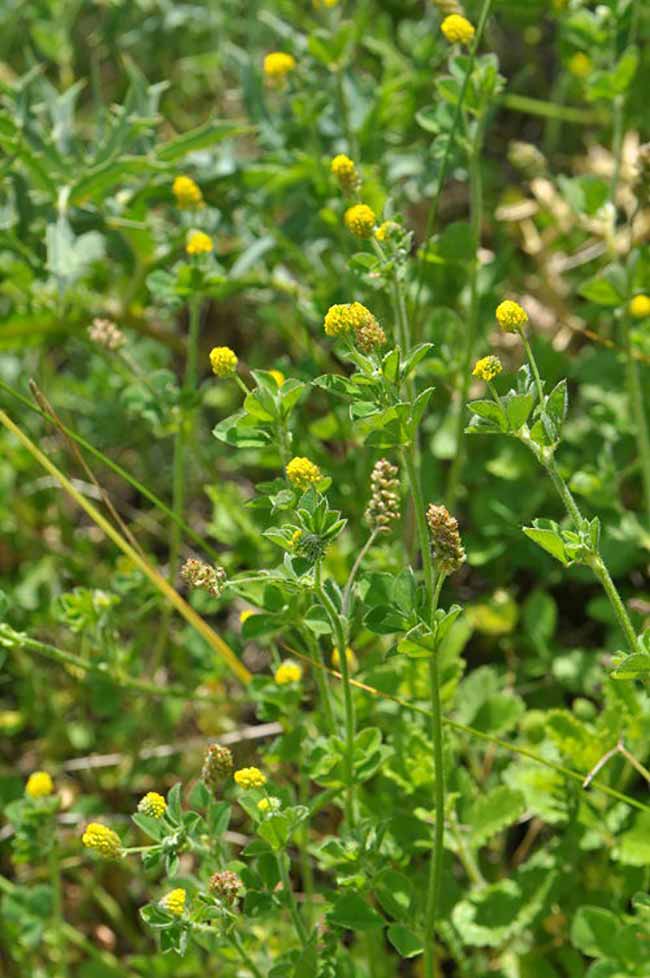
Black Medic is a tiny, low-growing weed with bright yellow flower clusters that look like miniature pompoms. It tends to pop up in compacted soils and grassy areas like sidewalks, driveways, and patchy lawns. Though small, it serves a useful purpose in nature—it helps fix nitrogen in the soil, making it richer for other plants. Still, it can spread easily and compete with turfgrass. If there are just a few, hand-pulling is easy. For larger patches, a selective herbicide for broadleaf weeds is usually needed.
________________________________________
8. Golden Clover
Botanical Name: Trifolium aureum (Golden Clover)
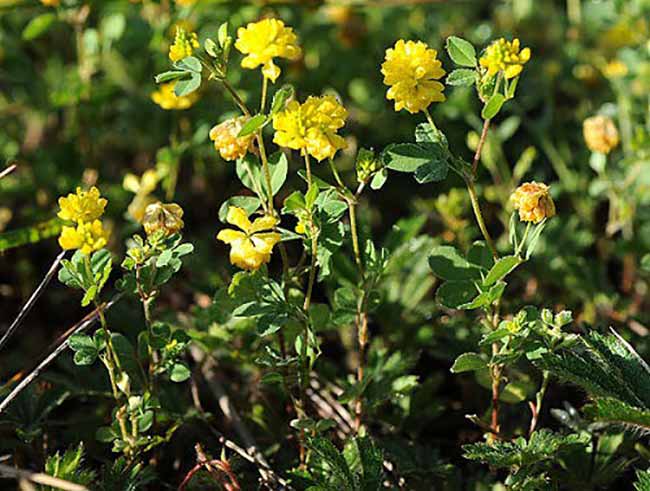
Golden Clover may be labeled a weed, but it has its benefits. This sunny yellow bloomer is part of the legume family and plays a helpful role in enriching soil by fixing nitrogen. You’ll often find it in meadows, roadsides, and disturbed soils. Livestock love it, and bees are frequent visitors when it blooms. The plant has a bushy growth with rounded yellow flower heads and clover-like leaves. Though it spreads slowly, if you’re managing a tidy lawn, you might want to remove it before it crowds out your grass.
________________________________________
9. Bird’s Foot Trefoil
Botanical Name: Lotus corniculatus
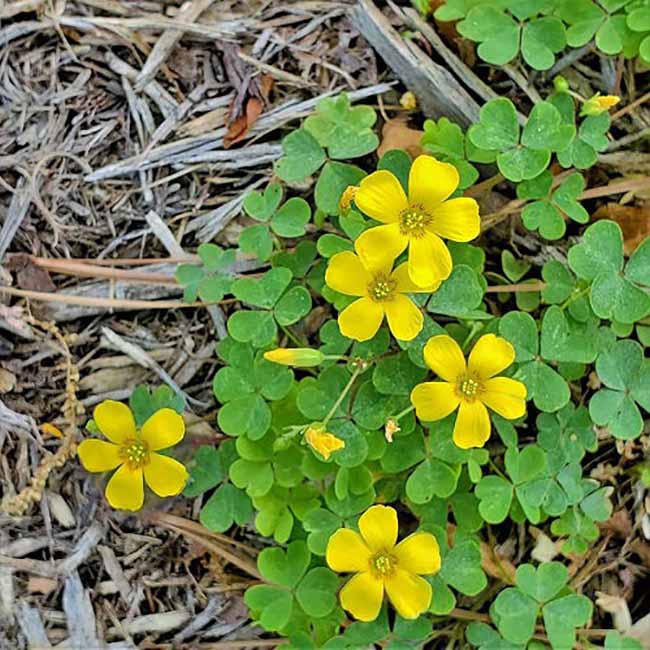
Don’t be fooled by its sweet name—Bird’s Foot Trefoil is a strong, fast-spreading plant. It usually grows around 3 to 5 feet tall and features soft yellow flowers that look like small pea blossoms. If you look closely, you’ll see they’re covered in tiny hairs. While it’s considered invasive in many areas, it does have some helpful traits. This plant can stop soil from washing away near roads and slopes. It’s also great at surviving poor soil and dry conditions, making it a survivor in tough spots.
10. Wild Parsnip
Botanical Name: Pastinaca sativa
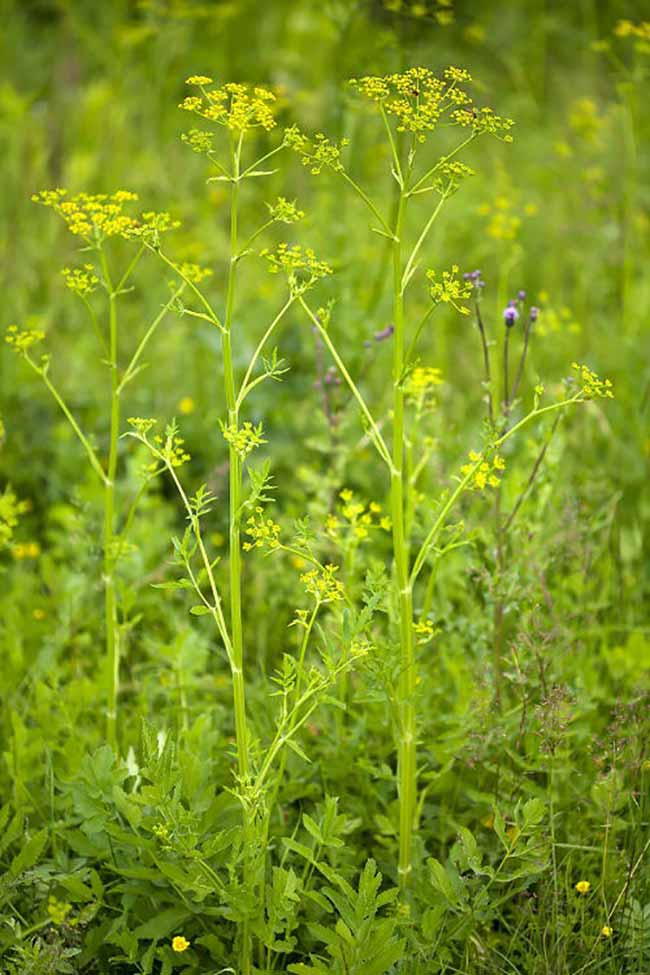
Wild Parsnip might look pretty with its yellow flower clusters, but this is a plant you’ll want to avoid touching. Growing up to 5 feet tall, its umbrella-shaped flowers bloom during summer and attract lots of insects. However, the sap inside the plant can cause painful skin burns if it gets on you and is then exposed to sunlight. It’s a perfect example of a weed that hides danger behind a beautiful face. Best to admire from a distance!
11. Purslane
Botanical Name: Portulaca oleracea

Purslane is a low-growing plant, barely reaching 6 inches in height, but it can spread across a wide area—almost 2 feet! It thrives in hot, dry areas and is known for its thick, juicy leaves. These leaves are actually edible and packed with nutrients, often used in salads or stir-fries. Its small yellow flowers open up when the sun is shining bright. So if you see this creeping around your garden, don’t pull it just yet—it might be your next healthy snack!
13. Canada Goldenrod
Botanical Name: Solidago canadensis

At first glance, Canada Goldenrod doesn’t look like a weed at all. Its tall stems and soft, golden-yellow blooms grow in a shape that resembles a pyramid or plume. It’s a real beauty in late summer and early fall gardens. But beware—it can quickly take over if left unchecked. It loves slightly moist soil and full sun, and pollinators like bees and butterflies adore it. While it’s often found along roadsides and fields, many gardeners let it stay because it adds a bright splash of color.
14. Wild Radish
Botanical Name: Raphanus raphanistrum
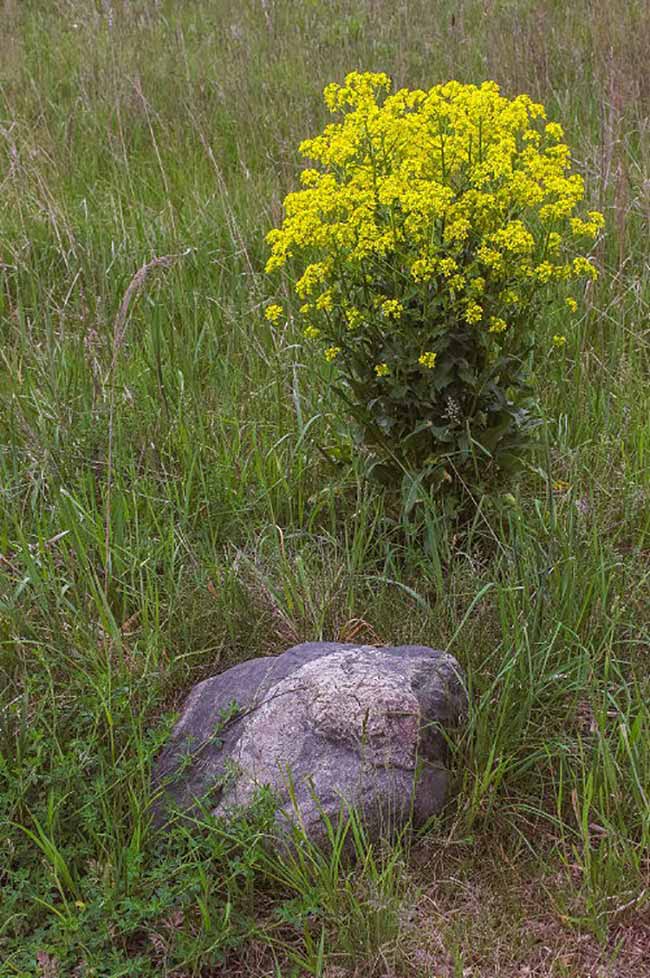
Wild Radish might not grow the radish root we eat, but it’s from the same plant family. You’ll often see it popping up in vegetable gardens, especially in spring and early summer. It grows fast and has light yellow flowers that sometimes have a hint of purple or white. This weed prefers open sunny areas and spreads easily, so it’s hard to control once it settles in. Still, the flowers add a soft beauty to otherwise plain garden beds.
15. Common Evening Primrose
Botanical Name: Oenothera biennis

This unique plant blooms when most others are closing up for the night. The Common Evening Primrose has yellow flowers that only open in the evening or on cloudy days. It grows in open fields, along woodland edges, and in disturbed areas. Native Americans once used parts of this plant to help with pain and other health issues. The plant usually grows tall and slender, with large buds that slowly unfold into bright flowers as the sun goes down. It’s a night owl among weeds!
16. Yellow Nutsedge
Botanical Name: Cyperus esculentus

At first glance, Yellow Nutsedge doesn’t seem like much. Its flowers are more golden-brown than bright yellow, but don’t be fooled—this plant is a real garden invader. It spreads underground using sneaky little tubers and rhizomes, which makes it very hard to get rid of. Even if you pull it out, it often grows right back from what’s left underground. It’s not a grass, but it sure looks like one, which is why many gardeners don’t spot it until it’s everywhere. It prefers moist soil and full sun, and once it’s in your yard, it’s ready to fight for space!
17. Common Ragwort
Botanical Name: Senecio vulgaris
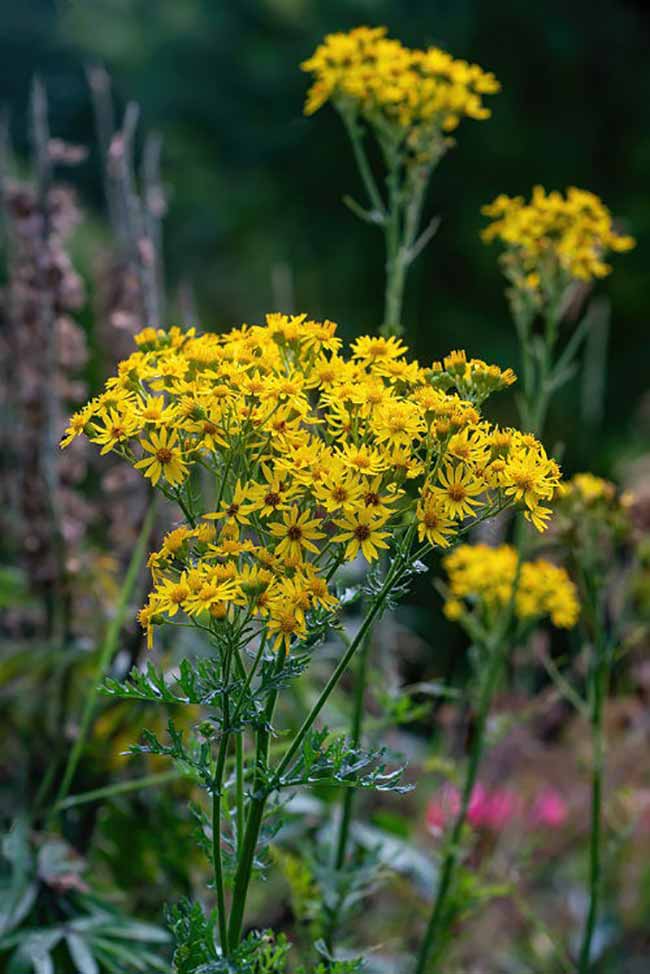
Bright and cheerful in appearance, Common Ragwort looks a lot like a daisy with its yellow petals and central disc. But don’t let its beauty fool you—it’s toxic. This weed contains dangerous chemicals called pyrrolizidine alkaloids, which can harm animals like horses and cows if they eat it. It thrives in pastures, gardens, and roadsides, especially in nutrient-poor soils. Despite its risks, it does attract bees and butterflies, making it an important—but tricky—part of some ecosystems.
19. Yellow Rocket
Botanical Name: Barbarea vulgaris
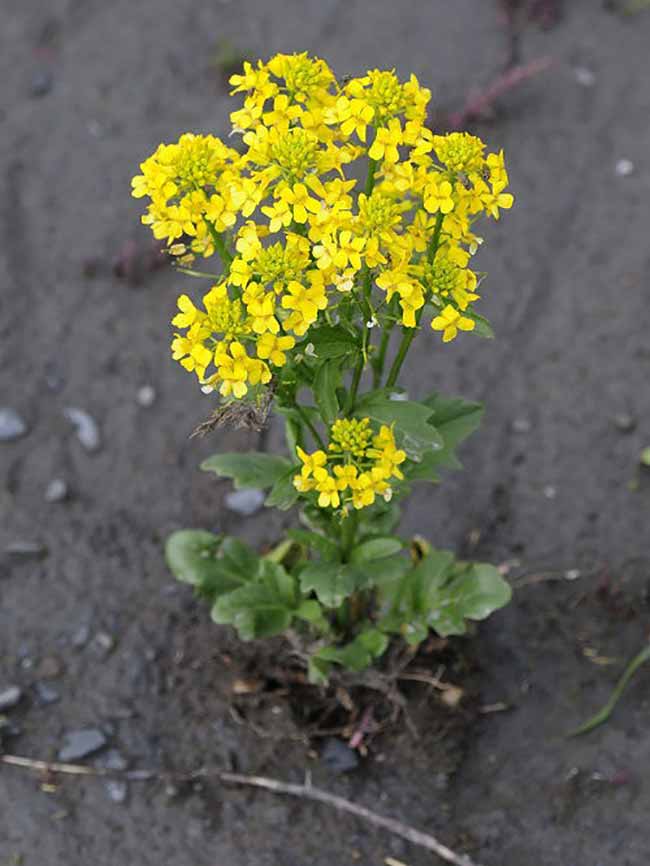
Yellow Rocket is a compact little plant, rarely growing taller than 8 inches. Its thin stems shoot upward and are dotted with clusters of vivid yellow flowers. You’ll usually find it blooming in early spring when not much else is flowering. It grows well in disturbed soil—like on roadsides, farm fields, or recently dug-up garden beds. Even though it looks harmless, it can spread quickly and compete with other plants if left alone. The leaves are edible when young and have a spicy, mustard-like taste!
20. Narrow-leaf Plantain
Botanical Name: Plantago lanceolata

Narrow-leaf Plantain is one of those weeds that shows up in nearly every lawn, from the countryside to city parks. It’s easy to spot with its long, narrow leaves and small yellowish flower spikes. What many people don’t know is that it’s edible and full of nutrients! Both the leaves and seeds can be tossed into a salad or brewed as a tea, and they’re packed with vitamins A, C, and K. Plus, it’s known for helping soothe skin and stomach problems. A weed with health perks—what a bonus!
21. Creeping Buttercup
Botanical Name: Ranunculus repens
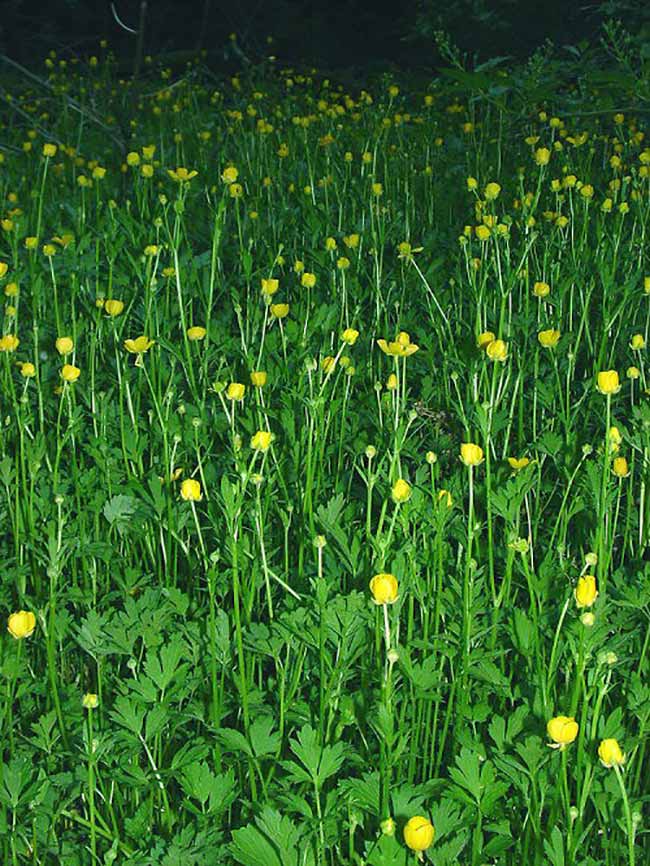
The Creeping Buttercup is a bright, low-growing weed with shiny yellow flowers that catch the sunlight like little gold coins. But it’s not as sweet as it looks. This plant spreads quickly with creeping stems that root at every node, forming a thick mat that smothers everything in its path. You’ll often find it in damp, shady lawns or garden beds, where it thrives in the cool soil. If you see one, there are probably more on the way—it’s a fast mover with a love for moisture.
22. Marsh Yellowcress
Botanical Name: Rorippa palustris
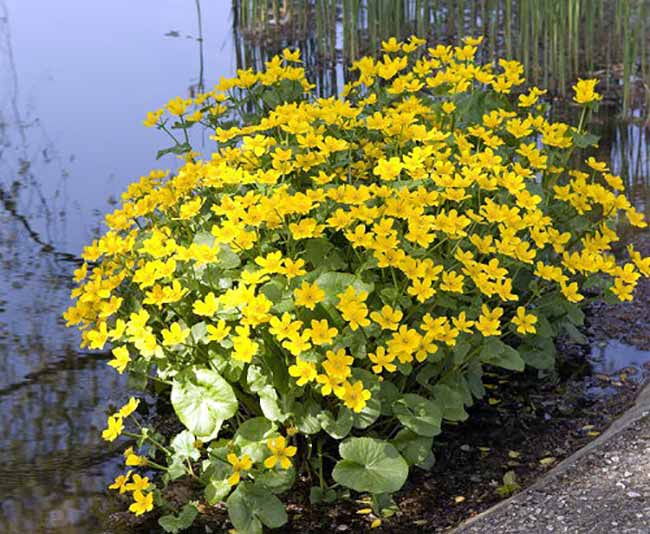
True to its name, Marsh Yellowcress loves wet places. Think marshes, wet meadows, pond edges, or any soggy patch in your yard. It’s a member of the mustard family, and its bright yellow flowers and rounded leaves make it easy to spot in moist habitats. While it doesn’t usually invade dry gardens, it can take over in wet zones and ditches. Despite being a weed, it plays a role in supporting wetland wildlife, making it an important plant in its own environment.
________________________________________
23. Yellow Salsify
Botanical Name: Tragopogon dubius

Yellow Salsify is a curious plant that gets different reactions depending on who you ask. Some folks think it’s a lovely wildflower, while others call it an aggressive weed. It has long, thin yellow petals that open during the morning and close by afternoon—like it’s keeping a secret. As it ages, it forms a huge dandelion-like seed puff that’s fun to blow on but dangerous for spreading! It attracts butterflies and bees and is often found in open fields, roadsides, and abandoned lots.
24. Creeping Cinquefoil
Botanical Name: Potentilla reptans
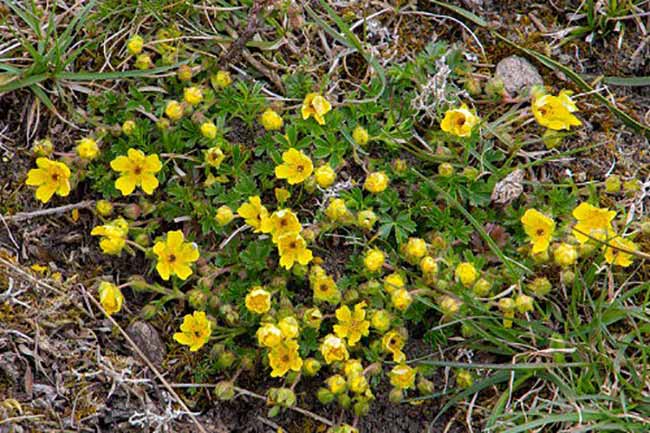
Creeping Cinquefoil is a ground-hugging plant that’s easy to miss at first—but once it spreads, it forms thick mats that are hard to ignore. Its five-petaled yellow flowers can appear alone or in small clusters, while its leaves look a bit like strawberry leaves. It only grows up to about 4 inches tall, but it creeps along the ground, rooting wherever the stem nodes touch soil. This weed loves open, disturbed areas like gravel paths, driveways, and dry lawns. Once it settles in, it’s tough to evict!
25. Butterweed
Botanical Name: Packera glabella
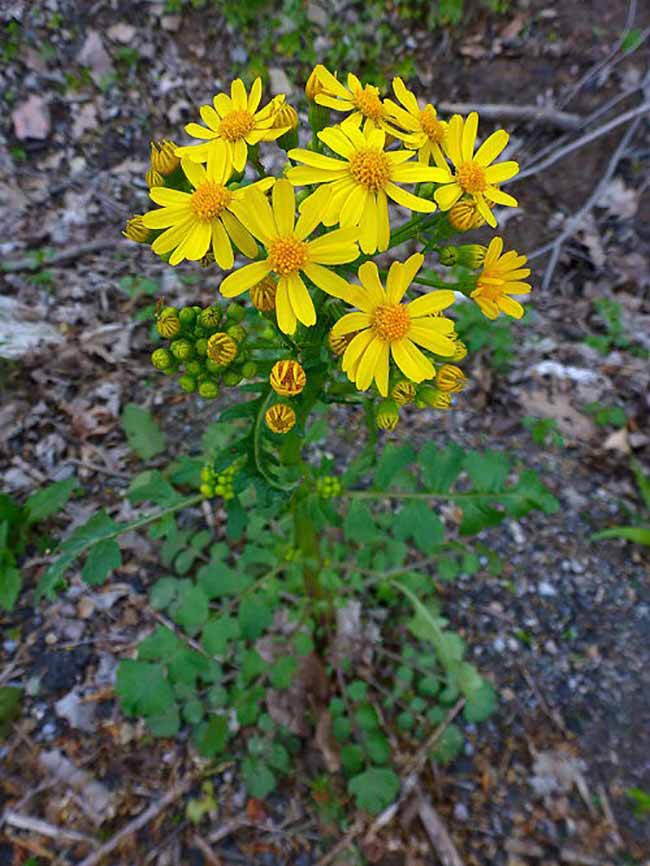
Butterweed may catch your eye with its bright yellow daisy-like blooms, but behind that cheerful color is a fast-spreading invader. This plant doesn’t just drop a few seeds—it spreads by the thousands, creating dense colonies in no time. Even worse, it releases allelopathic chemicals into the soil that can inhibit the growth of surrounding plants. You’ll typically find it in moist areas like fields, ditches, and along riverbanks. It may look like sunshine, but Butterweed is bad news for biodiversity in your garden.
________________________________________
26. Dandelion
Botanical Name: Taraxacum officinale

Dandelions are probably the most recognizable yellow weed out there. Kids love blowing the seed heads, but gardeners? Not so much. These sunny weeds have deep taproots that make them very hard to pull out completely. If you leave even a small piece of root behind, it’ll grow back. While dandelions are edible—leaves, roots, and flowers included—they’re also persistent and competitive. They’ll quickly take over garden beds and lawns if not kept in check. If you like them, try growing them in containers instead of open soil.
________________________________________
27. Skeleton Weed
Botanical Name: Chondrilla juncea
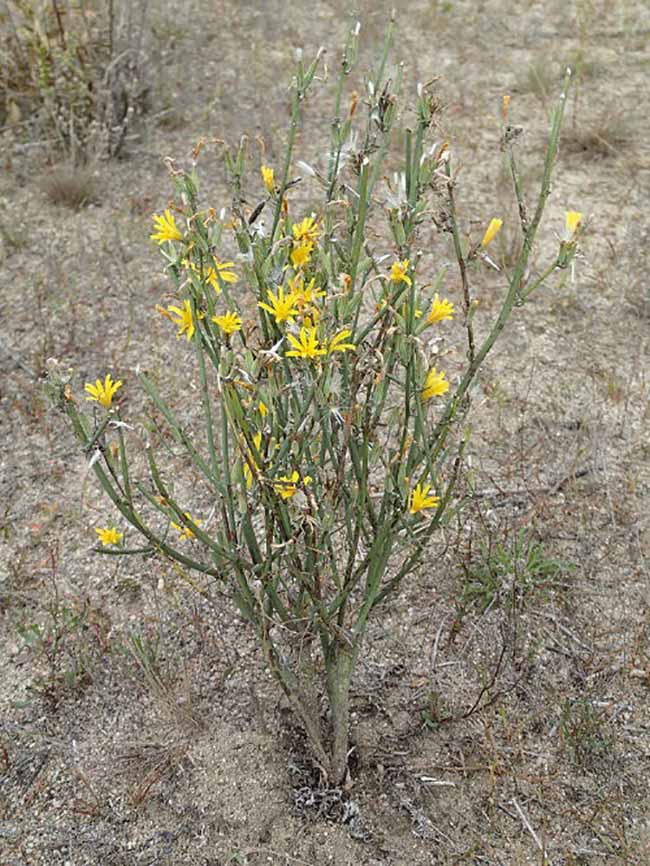
Skeleton Weed gets its spooky name from its thin, leafless stems that look like bony fingers. Don’t be fooled by its delicate appearance, though—this plant is a survivor. It grows up to 4 feet tall and produces seeds that are easily carried by the wind, allowing it to spread far and wide. The weed thrives in dry, sandy soils and can outcompete native plants due to its rapid seed production and tough root system. Once it’s established, it’s notoriously hard to control.
________________________________________
28. Oxalis
Botanical Name: Wood sorrels (Oxalis spp.)

Oxalis is one of the prettier weeds on this list. With its clover-like, heart-shaped leaves and buttery yellow flowers, it’s easy to think it belongs in a flower bed. But make no mistake—it’s aggressive and stubborn. It spreads by both seeds and underground runners, often popping up between cracks in sidewalks or throughout your garden. The leaves contain oxalic acid, which gives them a tangy taste but can irritate skin and is toxic to pets in large amounts. Wear gloves when handling it, and remove the entire root to keep it from coming back.
________________________________________
29. Wintercress
Botanical Name: Barbarea vulgaris
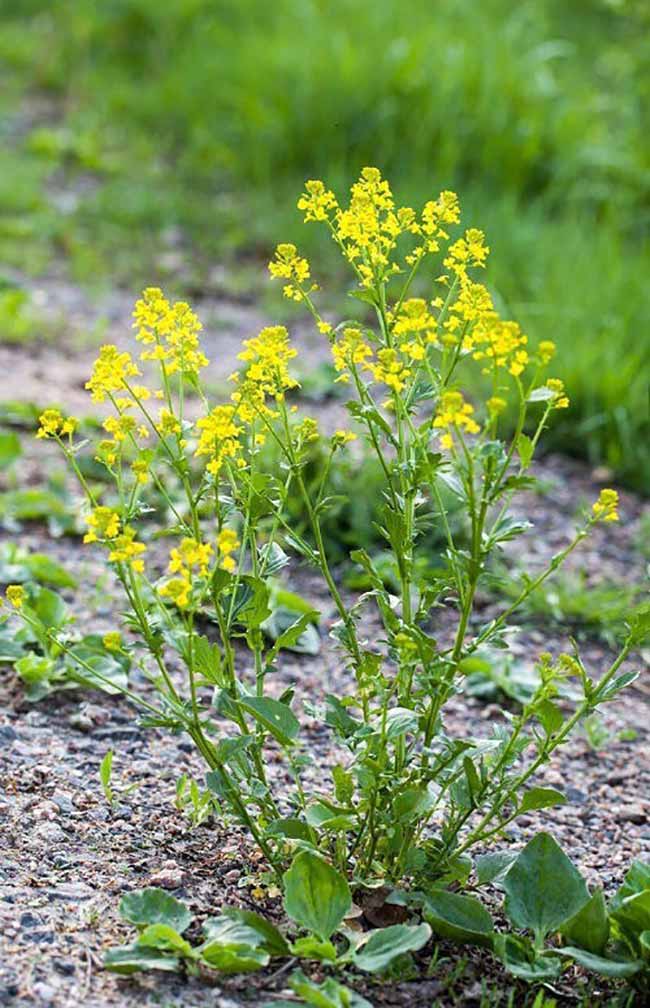
Wintercress may be labeled a weed, but it’s actually quite useful. A member of the mustard family, it features clusters of small yellow flowers and deep green, lobed leaves. You can eat the young leaves—they have a peppery bite similar to arugula. It thrives in early spring, often growing along roadsides, garden edges, and forest openings. While edible and nutritious, Wintercress spreads quickly, especially in disturbed soil, so if you’re not harvesting it, you might want to pull it before it takes over.
________________________________________
30. Garden Loosestrife
Botanical Name: Lysimachia vulgaris
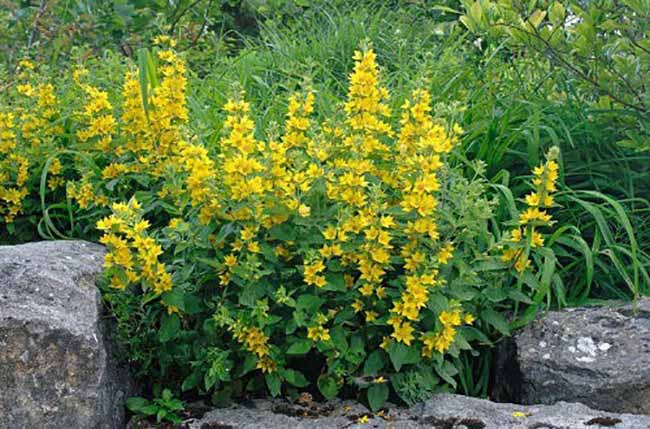
Garden Loosestrife sounds like something you’d find in a cottage garden, and at first glance, it fits the bill. It can grow up to 10 feet tall with clusters of small yellow flowers and fuzzy stems. But this wetland-loving plant is an invasive powerhouse. It spreads through both seeds and underground rhizomes, making it hard to control once it takes root. You’ll most often find it near lakes, rivers, and ponds, where it outcompetes native wetland plants. It’s a towering beauty—but it’s best admired from a distance.
________________________________________
31. Spanish Broom
Botanical Name: Spartium junceum
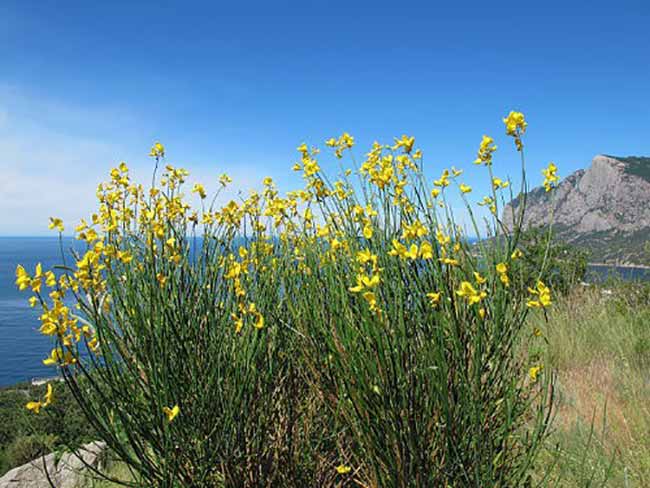
Spanish Broom is a tall, shrubby weed that puts on a showy display of bright yellow blooms. It can grow as tall as 10 to 15 feet, and you’ll often see it brightening up roadsides or hillsides. But here’s the problem—it’s an aggressive spreader. Once it gets established, it forms dense thickets that block sunlight and prevent other plants from growing underneath. It also dries out quickly, increasing wildfire risk in some areas. If it pops up in your yard, don’t wait—cut it back before it takes over.
________________________________________
32. Sow Thistle
Botanical Name: Sonchus arvensis

With spiky, dandelion-like flowers and thorny leaves, Sow Thistle is one weed that’s hard to love. It looks a bit like a rougher version of the common dandelion but grows taller—up to several feet. It’s a perennial, meaning it’ll come back year after year unless you remove the entire root system. Sow Thistle spreads both by seed and underground roots and can be particularly annoying in lawns, fields, and garden beds. It also exudes a milky sap that can irritate the skin. Gloves are a must when pulling it out!
33. Yellow Toadflax
Botanical Name: Linaria vulgaris

Also known as “Butter and Eggs” because of its vivid yellow petals with orange centers, Yellow Toadflax is as charming as it is invasive. Originally brought from Europe in the 1600s for ornamental and medicinal purposes, it has since spread like wildfire across North America. Its deep root system makes it extremely hard to control, and it reproduces by both seed and creeping rhizomes. Once it takes hold, it can dominate fields, roadsides, and pastures—suffocating native plants and creating dense colonies. It’s a serious competitor, especially in dry, open areas.
________________________________________
34. Ragwort
Botanical Name: Jacobaea vulgaris
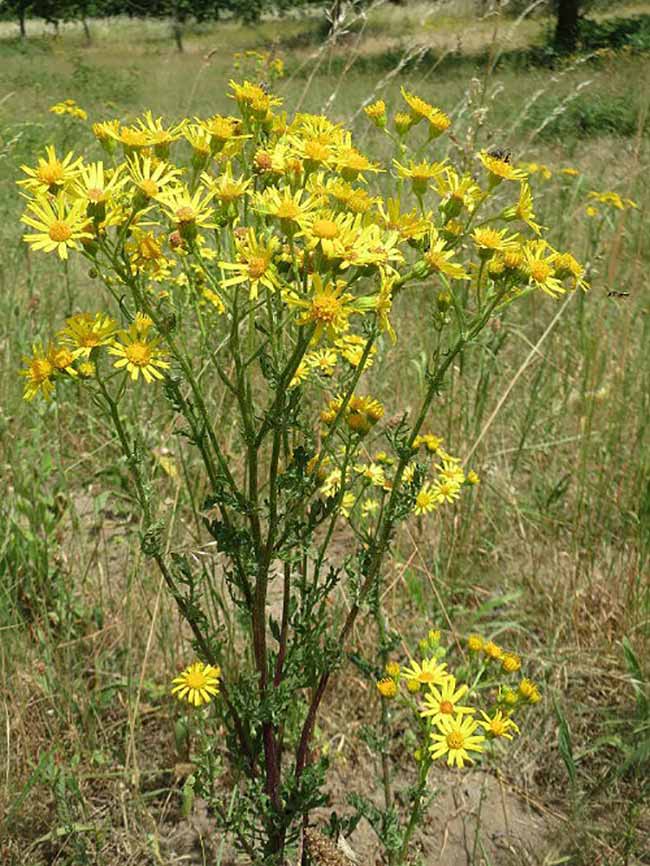
Ragwort often appears like a burst of sunshine on trails and hillsides, but this weed comes with a toxic twist. While its daisy-like yellow flowers can be quite pretty, every part of this plant is poisonous to grazing animals like cattle and horses. The danger lies in a toxin called pyrrolizidine alkaloid, which builds up in the liver over time. People with sensitive skin might even develop irritation from touching it. It spreads via windborne seeds, making early removal essential if it crops up in your area. Pretty—but potentially deadly.
________________________________________
35. Grass-leaved Goldenrod
Botanical Name: Euthamia graminifolia

If you’re wandering through fields in late summer, you may spot Grass-leaved Goldenrod lighting up the landscape. Native to much of North America (but curiously absent from states like Florida and Kansas), this golden beauty grows in clumps and produces tight bunches of small yellow blooms. While technically native, it behaves like a weed due to how fast it spreads and how easily it outcompetes other meadow plants. It prefers moist soil and full sun, often appearing near wetlands and drainage areas. Pollinators love it, but it can be a maintenance headache for gardeners.
________________________________________
37. Yellow Hawkweed
Botanical Name: Hieracium caespitosum


At first glance, Yellow Hawkweed might trick you into thinking it’s a dandelion. But look closer: the flower heads are smaller, the stems are fuzzy, and it often grows in dense clusters. This weed spreads not just by seeds, but also by stolons (above-ground runners), making it highly invasive. Found in meadows, lawns, and even forest clearings, it forms mats that choke out other plants. Removing it can be tough—you’ll need to dig up the runners and dispose of them carefully to prevent regrowth.
________________________________________
38. Yellow Lantana
Botanical Name: Lantana camara
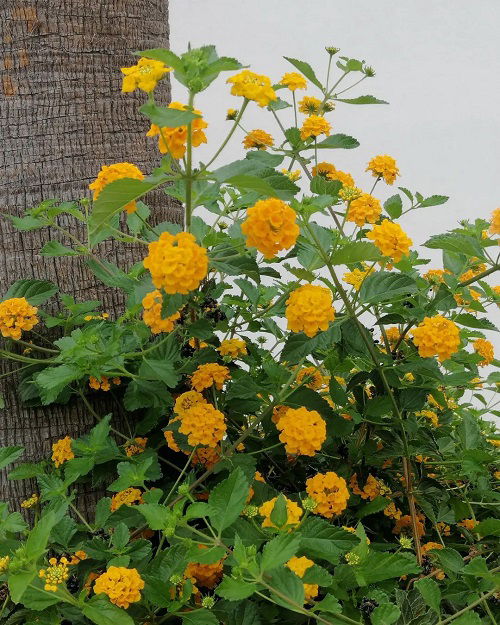
Yellow Lantana is one of those deceptive plants—visually stunning but secretly sinister. It blooms with bold yellow clusters throughout summer and autumn, making it a favorite in warmer regions. But here’s the problem: it’s toxic to humans, cats, dogs, and livestock. Ingesting even a small amount can lead to serious gastrointestinal issues or worse. On top of that, it spreads aggressively, especially in tropical and subtropical climates. If you’re growing it for its flowers, do so in containers and keep it well-controlled. Otherwise, this vibrant beauty can turn into a backyard bully.

